Meet electric heating boilers 220v
You may be able to purchase a heating or electrode electric boiler for heating a 220 V house either at your place of residence or in online stores. But the most basic thing here is to correctly calculate the power so that it is enough to heat your home.
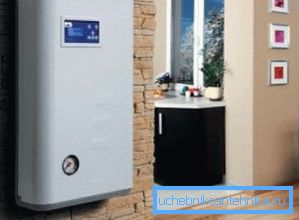
In addition, you will have to take into account other parameters, for example:
- the cross section of the wiring in the building in relation to the total power consumption;
- or the fact that the stability of the voltage in the network.
Of course, there are a lot of different nuances and we can’t do without them when installing such devices, therefore, we will try to acquaint you with the most important ones.
Electric boilers
The main differences
Note. All electric boilers operating on 220V or 230V mains are divided into two main categories according to the method of heating a liquid. One of them heats it with a tubular electric heater or heating element, and the other with electrodes using an ionization method.
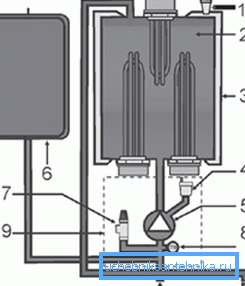
Explanations for the photo:
- TENY - one at the top and two below;
- Liquid heat exchanger;
- Insulating layer;
- Expansion tank;
- Safety valve OB;
- Pressure meter;
- Hydro group (supply and wiring coolant);
- Heat exchanger air vent: A - return from the system, B - supply to the system
- Electric boilers that work on heating elements, as a rule, are mounted on the wall (mounted), have a rather attractive appearance and small size, which allows them to fit perfectly into the interior of the room. Start-up thermostatic valves in automatic mode provides the desired level of heating fluid to maintain a stable microclimate in the room. This is facilitated by several sensors that monitor not only the temperature of the liquid, but also the state of the air in the room.

- The shell of the heating tube is usually made of aluminum, steel or titanium, and inside there is a spiral of nichrome with contact rods and all of this is pressed into the tube with quartz sand. The power of the unit mainly depends on the power of the heating elements themselves and their number, household installations (up to 4 kW) are powered from the 220V network (single-phase), but more powerful ones already need 380V (three-phase). Some boilers include an auxiliary circulating pump, which makes it easier to install and start the heating circuit.
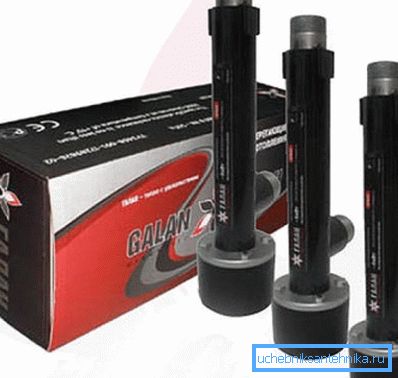
- A completely different heating of the coolant occurs in electrode-type boilers, which, like TEN's, operate on a variable network of 220V and 380V (single-phase and three-phase), and the number of phases depends on the power of the unit. But the electrode type of devices differs not only by the principle of heating, but also by lower power consumption, although the price of those and other devices with similar output data is approximately the same.
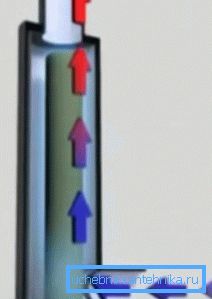
- In such boilers, two polar electrodes are mounted, which are located directly in the heated fluid and the ionization process takes place here. In our network, the frequency of the current is 50 Hz, therefore, the polarity will change as many times per second, and the ions will respectively change the direction of motion. From such a frequency they heat up, that is, the heat carrier is heated.
- One can note the safety of such devices - in the event of a fluid leakage, the system stops its operation, since the material for the circuit of the electrode circuit simply disappears. It turns out that in the heating elements the circuit closes the nichrome spiral, and here - the coolant itself.
Note! I want to immediately dispel the concerns of users who are not familiar with the laws of electricity - the current passes along the path of the shortest resistance - in this case - between the electrodes and the danger zone is only between them. The heat carrier in the system is not energized, therefore, it is safe, as the instruction on the use of the boiler says about it.
Tenovy models
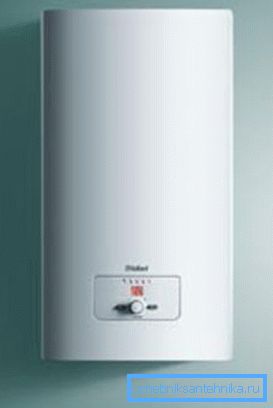
In the upper photo you see the WAILLANT eloBLOCK TEN electric boiler. Such a modification occupies a leading position in world standards, not only in technical characteristics, but also in design, which allows the heating device to perfectly fit the interior of the room.
The power of this device with different modifications can be from 6 to 28 kW, so different models can be powered either from ?220V or from ?380V - it all depends on the consumed and produced power of the unit.
WAILLANT eloBLOCK has a maximum water heating temperature of 85? C with a volume of a heating expansion tank of 7 liters, a minimum working pressure of 0.8 bar and a maximum of 3 bars. During operation, it is recommended to maintain the pressure within 1-2 bars, although, if necessary, this is an indicator, of course, can be changed. The dimensions of the device height / width / depth are 740x410x330 mm with a mass of 34 kg.
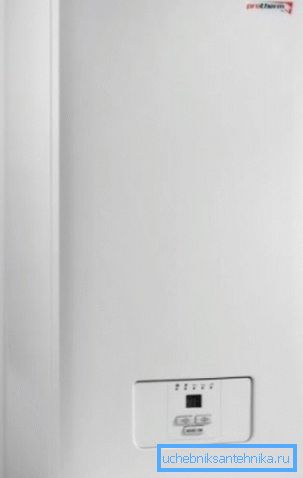
TENOV one-planimetric boiler of the hinged PROTHERM 12K type represents the heating unit where models 6K and 9K work from a variable network 220B. But the model 12K, 18K, 21K, 24K is already connected to the three phases ?380V, but at the same time, the 6K and 9K models also have the possibility of a three-phase connection.
The device has 2 heating elements with six power levels, the nominal power is 6 kW with an average efficiency of 99%. The maximum water temperature is 85? C, the maximum working pressure of the pump is 0.8 bar, the minimum is 3 bar, the recommended 1-2 bar.
Electrode models

In Russia, most often in stores you can find products of the domestic manufacturer Galan, and this is very good, since such units can heat a room with any area and can cope with this by no means worse than expensive imported counterparts.
Such devices you can easily install with your own hands, of course, if you understand the heating circuits. Flow type ionic heaters are widely used both for radiator circuits and for floor heating systems - the main condition is that the boiler is in a vertical position and is above the supply pipe.
| Options | Optimal use of boilers | |||||||
| Hearth 2 | Hearth 3 | Hearth 5 | Hearth 6 | Geyser 9 | Geyser 15 | Volcano 25 | ||
| Room dimensions (m3) | 80 | 120 | 200 | 250 | 340 | 550 | 850 | |
| Rated power consumption (kW) | 2 | 3 | five | 6 | 9 | 15 | 25 | |
| Rated voltage (V) | 220 | 220 | 220 | 220 | 380 | 380 | 380 | |
| The average power consumption with sufficient insulation of the room (kW / h) | 0.5 | 0.75 | 1.25 | 1.5 | 2.5 | four | 6,6 | |
| Maximum current strength of each phase (A) | 9.1 | 13.7 | 22.7 | 27.3 | 13.7 | 22.7 | 37.5 | |
| Nominal current for automation in electromechanical version (A) | ten | sixteen | 25 | 32 | 3 to 16 | 3 to 25 | 3 to 40 | |
| Copper wire cross section (mm2) | 220V | four | four | four | 6 | - | - | - |
| 380V | - | - | - | - | four | four | 6 | |
| The recommended amount of coolant in the heating system (l) | 20 - 40 | 25-50 | 30 - 60 | 35 - 70 | 50 - 100 | 100 - 200 | 150 - 300 | |
| Internal diameter (DN) of nozzles at the inlet and outlet in the boiler (mm) | 25 | 25 | 25 | 25 | 32 | 32 | 32 | |
| Unit Length (mm) | 250 | 275 | 320 | 335 | 360 | 410 | 460 | |
| Unit weight (kg) | 0.85 | 0.9 | 1.05 | 1.1 | 5.0 | 5.3 | 5.7 |
Table of ratio of power of the boilers to the size of the room
Note. The table shows the modifications of the manufacturer Galan, but they are constantly improved over time. Therefore, these parameters can be perceived only as general, but not precisely characterizing one or another type of boiler.
Conclusion
As you can see, the installation of any electric boiler in terms of complexity will be much easier than the installation of gas, liquid fuel and even solid-fuel units, since you will not have to solve the problem of exhausting combustion products - here they simply do not exist! In this article there is a video clip that will help you become better acquainted with the material.